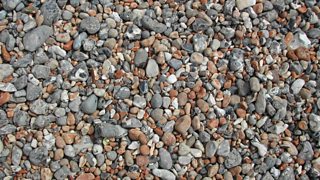29 things that only people who collect pebbles will understand
Can't seem to stop picking up pebbles? You're not alone – although it can sometimes feel that way. Here are a few situations that all pebble collectors will be able to identify with.
1. You have quads and hamstrings of steel: the result of many hours of crouching, then standing up again, then crouching, then standing up again, then crouching...
2. Your family and friends can’t understand how you can spend literally hours wandering around on beaches and hillsides, picking up pebbles and putting them down again.
3. Every jacket and coat you own has a random pebble in at least one of the pockets, and sometimes the lining. You are delighted to rediscover it every single time.
4. Your family is constantly going on at you for leaving pebbles in unexpected places, like the glove compartment of the car. Or their jacket pockets.
5. You pack extra light for holidays abroad because you know you’ll need the extra weight allowance for your new, exotic pebbles on the journey home.
6. You’ve lost count of the number of books you’ve left in foreign hotels because it came down to them or the pebbles.
7. You know that the best pebbles are a pleasingly symmetrical shape.
8. Or an interestingly bizarre shape.
9. You appreciate the uniquely satisfying “hand-feel” of a good pebble.
10. And it’s really nice to hear them clinking gently when you put them in a bag.
11. Some of the best ones are unusual colours.
12. Or are pure white, like quartz.
13. Pebbles that have veins of a different colour rank very highly.
14. So do rocks that have been smashed apart by some exciting elemental force, allowing you to see the inside.

15. Your family cannot understand how you can attribute value to or even tell the difference between individual pebbles on a beach.
16. You cannot understand why your family cannot understand the innate supremacy of certain pebbles over others.
17. If you live with other people, there is often an expectation that your pebble collection should have “limits” of some kind.
18. You do not recognise this requirement.
19. You love the fact that every pebble in your collection represents a time and a place – not just in your own life, but in a vast geological continuum.
20. The fact that you cannot always remember exactly where you acquired each pebble is of little importance.
21. When it comes to downsizing your collection, you can spend hours agonising over which pebbles to get rid of.
22. Most of the time you just end up relocating pebbles from the main collection to other, less obvious places.
23. You often discover bags of pebbles in hiding places you’d forgotten about years ago.
24. For you, this is obviously a joyful reunion – but your family always act like it's some kind of relapse.
25. You know that the best place to inspect your collection is in the bath, where the pebbles can get all shiny and show their colours properly.
26. You may even have invested in a pebble polishing machine.
27. Yes. They exist.
28. If you collect pebbles and hadn’t heard about pebble polishing machines, you just opened a new tab to search for them.
29. We know you.
In The Essay: Cornerstones, five writers reflect on how the places that matter to them are shaped by their underlying geology.
Listen live or online to learn how quartz, millstones, igneous rocks, coal and chalk have all made their mark.
The Essay: Cornerstones

Quartz: King of pebbles
The writer Linda Cracknell explores the enduring appeal of quartz's luminosity.
Essential kit for pebble collectors
Geologist Clive Mitchell from the British Geological Survey recommends tools for your next rock-finding mission
A cloth bag
You need something strong to keep your collection in. Be careful to carry jagged or rough samples separately to avoid damaging your other pebbles. They’ve been bashed about by the sea a lot, but you still may need to individually wrap your samples to protect them from scratches.
Lots of people have trouble remembering where they found their favourite pebbles
A camera or smartphone
Photos are great for recording your finds and sharing them with other rock enthusiasts online. And it means you won’t be weighed down by hundreds of samples.
Paper and an indelible marker
Lots of people have trouble remembering where they found their favourite pebbles. Geologists record samples by logging their GPS coordinates on a digital map, but that’s a bit harder for the average person.
I’d recommend writing the location on the bag they’re kept in, if it’s plastic, or slipping in a label to store them with. But lots of people find a photo is the best way of remembering where a pebble comes from.
Fold-up hand lenses
A typical hand lens has x10 magnification. They're cheap to buy, and you use them to look up close at your pebble and start to work out what it is.
Hold the lens very close to your eye, then hold the pebble right up to it. Depending on the type of rock, it's sometimes easier to see crystals on the surface of a pebble if you wet it first.
The lenses will help you start seeing the detail, and that’s when you get the real “oooh!” factor. Kids especially love seeing all the textures and crystals. It’s my goal to convert them all into little geologists.
A reference book or website
When it comes to identifying your pebbles, there are lots of reference books out there. But a lot of them only show pictures of outstanding, museum-quality specimens, which you’re unlikely to find washed up on the beach.
Many areas in the UK have websites run by local pebble enthusiasts or geologists, so do some online research about the geology of the area in advance if you can.
You should also check local bylaws to make sure there aren't any rules about taking away the things you find (although you shouldn't be taking away huge amounts of rock anyway).
Hammer, chisel and safety equipment (for advanced pebble enthusiasts only)
The outside of a pebble is often worn smooth, and it’s difficult to see what’s going on inside. Cracking a pebble open with a hammer and chisel can reveal the fresh rock surfaces within. You’re looking for textures, colours, and minerals: in certain circumstances you might even reveal an ammonite (a mollusc fossil) or a geode (a hollow stone partially filled with crystals).
This kind of equipment is more for the amateur geologist than the general pebble collector, and strictly for grown-ups only. If you're going to use a hammer to look inside a pebble, you should always wear safety goggles and gloves.
And use your common sense. The coast is often the best place to look for pebbles, but you must be careful. Cliffs are constantly falling and crumbling, so look out for warning signs and don't take any risks. Geologists wear hard hats and high-vis when they collect samples: don't feel that you can just wander up to a cliff and start hacking away with a hammer.
-
![]()
Cornerstones
Five writers reflect on how a favoured location is determined by its underlying geology.
-
![]()
Learn more about the natural world
A series of programmes made in partnership with the Natural History Museum.
-
![]()
Five books that could change your life
What was the book that first made you stop – think – wonder – and start to live your life just a little bit differently?
-
![]()
The dark history of the treadmill
How did a Victorian instrument of punishment become one of our favourite pieces of gym equipment?




